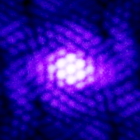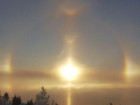|
Defining Planethood
|
|
| Watsisname | Date: Friday, 10.06.2016, 08:21 | Message # 166 |
 Galaxy Architect
Group: Global Moderators
 United States
United States
Messages: 2613
Status: Offline
| Not as long as you think.  Remember your example begins with an object on a hugely eccentric orbit! In a forming system, material is in essentially circular orbits, not orbits with eccentricity close to 1. How do you get a massive object on such an eccentric orbit to begin with? By scattering it. (Scattering also tends to increase the inclination). Remember your example begins with an object on a hugely eccentric orbit! In a forming system, material is in essentially circular orbits, not orbits with eccentricity close to 1. How do you get a massive object on such an eccentric orbit to begin with? By scattering it. (Scattering also tends to increase the inclination).
The math I was doing shows that even such a planet-crossing eccentric orbit would still involve scattering, and so we can safely rule out its existence. It could not exist on such an orbit for very long.
Quote midtskogen (  ) It's interesting to see that Earth is two and a half order of magnitudes more a planet than Mars, so Mars is much closer to being a non-planet (< 100) than to being a planet like Earth. So much for Mars as a second home for humans...
Being higher in the distribution does not make something "more a planet". It's not a planetary ranking system. It's a classification system with two distinct populations. Anything that is in the upper part of the bi-modal distribution is a planet. Anything that is in the lower part of the distribution is a dwarf planet. Why? Because dynamical processes naturally produce this clear separation between the two groups.
Suppose instead that Mars were between, say, 10 and 100. Then it would not clearly be a member of either population, and we would find that rather odd.

|
| |
| |
| JackDole | Date: Friday, 10.06.2016, 09:04 | Message # 167 |
 Star Engineer
Group: Local Moderators
 Germany
Germany
Messages: 1742
Status: Offline
| Quote Watsisname (  ) Soter's planetary discriminant
What value would have Planet 9 in this table? With about 10 Earth masses and a SemiMajorAxis of 600 AU (20 * Neptune).
Am I right in assuming that he would be a dwarf planet, according to this table?
Don't forget to look here.

|
| |
| |
| Watsisname | Date: Friday, 10.06.2016, 11:10 | Message # 168 |
 Galaxy Architect
Group: Global Moderators
 United States
United States
Messages: 2613
Status: Offline
| By Soter's discriminant? I have no idea. Take 10 Earth masses and divide it by the total mass within that region (besides itself). How much total mass is in that region?
This is why a scattering parameter is better for these cases -- we can compute based on parameters we can more easily observe. Let's try Margot's Π:

Taking m=10, M=1, a=600, and k=807 for a sun-like star, this evaluates to about 6.
6 is greater than 1 [citation needed], so this implies the object should be able to "clear its orbit", and would be defined as a planet by this metric.
However, all of the numbers associated with planet 9, including its very existence, are very speculative. So take this result with a mountain of salt:

|
| |
| |
| midtskogen | Date: Friday, 10.06.2016, 15:07 | Message # 169 |
 Star Engineer
Group: Users
 Norway
Norway
Messages: 1674
Status: Offline
| Quote Watsisname (  ) In a forming system, material is in essentially circular orbits
We may be somewhat spoiled with pretty much circular orbits. Wikipedia claims that many of the known planetary systems display much higher orbital eccentricity. There's evidence for planets with an eccentricity well above 0.5. Have these been scattered?
In our solar system we have one very dominant body, the sun, which may be somewhat unusual.
NIL DIFFICILE VOLENTI

|
| |
| |
| Watsisname | Date: Saturday, 11.06.2016, 05:47 | Message # 170 |
 Galaxy Architect
Group: Global Moderators
 United States
United States
Messages: 2613
Status: Offline
| To 'scatter' means to remove objects from the picture, dynamically speaking. So no, they were not scattered. High eccentricity planets are probably the result of secular interactions and Kozai mechanism. And the object in your example is e=0.998, which is an entirely different regime of eccentricity. More on that in a moment. First let's look at some data:

Of this sample of 850 planets with well characterized orbits, 289 of them have e<0.01. Then there is an immediate and huge dropoff in the distribution. The median is 0.07. The mean is 0.15. 7% have e>0.5. Only 2 have e>0.9. (One of those is HD 80606 b which is an insanely crazy place).
Let's take a moment to think about this. As with bi-modal distributions, you should expect dynamical processes to be responsible for the shape. In this case, there are a few. Most of the planets in the spike at e~0 are due to tidal circularization of close orbits. Most of the high eccentricity planets are due to the Kozai mechanism.
After discarding tidal circularization, the mean eccentricity is around 0.2. Not as nicely circular as our system, (it's about the same as Mercury's), but still "essentially circular". Simulations have no trouble with this.
Now for comparison, the 100,000 year Jupiter-crossing planet would have e=0.998. To put that in perspective, with a periapsis at Jupiter's orbit (5.2AU), it's semi-major axis would be 2150AU. In our solar system, the only viable pathway to this orbit is by scattering.
Such a resulting orbit is also enormously improbable -- the total orbital energy is very close to 0, meaning whichever interaction brought it to that orbit may as well have ejected it completely. So, this object does not exist, is improbable to ever exist, and if it did exist, would prove the rule anyway.  Scattering is a powerful measure because it's a powerful process. Scattering is a powerful measure because it's a powerful process.
Edit: Added links to more info about Kozai, and one of the more eccentric planets known because it's awesome.

Edited by Watsisname - Saturday, 11.06.2016, 11:43 |
| |
| |
| steeljaw354 | Date: Saturday, 11.06.2016, 21:55 | Message # 171 |
 World Builder
Group: Users
 Pirate
Pirate
Messages: 862
Status: Offline
| Lets say we have a 1 earth mass black hole, orbiting the sun where earth is and it's orbit is clear, is it a planet by the IAU terms?
|
| |
| |
| FaceDeer | Date: Sunday, 12.06.2016, 00:26 | Message # 172 |
|
Space Pilot
Group: Users
 Canada
Canada
Messages: 117
Status: Offline
| Yes. You don't really need to ask, though, the definition is rather straightforward and you can see for yourself:
Quote A "planet" is a celestial body that: (a) is in orbit around the Sun, (b) has sufficient mass for its self-gravity to overcome rigid body forces so that it assumes a hydrostatic equilibrium (nearly round) shape, and © has cleared the neighbourhood around its orbit. [1]
Criterion a: yes, it's orbiting the Sun.
Criterion b: yes, it's round due to self-gravity. Very much so.
Criterion c: yes, it has cleared its orbit.
It's unclear whether an Earth-sized black hole could even form, though, so this is a pretty hypothetical question. Black holes that small are hypothesized to have maybe been able to form during the big bang (primordial black hole) but there's no known process that could form them since then and there's no evidence that primordial black holes exist.
|
| |
| |
| Watsisname | Date: Sunday, 12.06.2016, 01:04 | Message # 173 |
 Galaxy Architect
Group: Global Moderators
 United States
United States
Messages: 2613
Status: Offline
| I would argue otherwise. While black holes are certainly very round (probably the most round things in the universe!), they are not round because of hydrostatic equilibrium.
Hydrostatic equilibrium means that for matter at all radii in a body, inward forces due to its gravity are balanced by outward pressure forces (and centrifugal forces if spinning). So it really only applies to distributions of matter. A black hole is not made of matter and there are no pressure forces. There is no balance of forces involved in producing the shape. If you put a particle near one, it just falls in.
So, black holes are not planets. They're distortions of the space-time. They have a very different physical nature and genesis. 

|
| |
| |
| steeljaw354 | Date: Sunday, 12.06.2016, 01:17 | Message # 174 |
 World Builder
Group: Users
 Pirate
Pirate
Messages: 862
Status: Offline
| Then if this black hole is a planet by the IAU rule, that rule needs an overhaul, if a 1000km rule instead of orbital clearing would eliminate that black hole from planet status because an earth mass black hole is about peanut sized. Oh did I forget to mention that any "planet" that doesn't orbit sun, it is NOT a planet regardless of it's mass or size? That's a bias rule there. And a rule like this 1) Must be round, 2) Must orbit a star, 3) Must have a diameter of 1000km or higher, 4) Must not undergo nuclear fusion or deuterium fusion currently or in the past, (Black holes, white dwarfs, neutron stars are eliminated from planet status) No complicated math needed here. Just simple observation. Honestly, would you rather just use this instead of having to do math? I would.
Edited by steeljaw354 - Sunday, 12.06.2016, 01:26 |
| |
| |
| Watsisname | Date: Sunday, 12.06.2016, 05:56 | Message # 175 |
 Galaxy Architect
Group: Global Moderators
 United States
United States
Messages: 2613
Status: Offline
| Black holes are not planets by any established rule -- their shapes are not defined by hydrostatic equilibrium.
Planets that don't orbit stars are 'rogue' planets.
Using a 1000km limit is unsatisfactory because it is a doubly-biased choice of number and unit, and the objects have a smooth distribution of sizes on that scale. You are choosing 1000km because you believe it is easier, not because there is anything fundamentally different about a 999km object and a 1001km object.
Quote Honestly, would you rather just use this instead of having to do math? I would.
No, because they are not on equal footing even without considering the math. If you had two classification systems that had equally low bias in their definitions, but varying levels of mathematical difficulty, then sure, I would use the easier one.

|
| |
| |
| FaceDeer | Date: Sunday, 12.06.2016, 06:13 | Message # 176 |
|
Space Pilot
Group: Users
 Canada
Canada
Messages: 117
Status: Offline
| Actually, I'd argue that it doesn't matter why a black hole is round. The criterion is "has sufficient mass for its self-gravity to overcome rigid body forces", and an Earth-mass object does indeed have sufficient mass to overcome rigid body forces.
But I'd also argue that Steeljaw's objection is silly, for exactly the reason I mentioned in my first response - as far as we're aware there's no such thing as an Earth-mass black hole. The fact that the IAU's definition gives funny results for imaginary made-up things is hardly a black mark on the definition.
Steeljaw, there's a separate definition the IAU uses for exoplanets. It was devised before the official definition for Solar system planets was arrived at and only needs to deal with objects large enough to be detected with current or near-term foreseeable technologies so it doesn't need to be as sophisticated as the Solar system one. Presumably it will eventually get refined to more closely match the Solar system planet definition now that we have one since. It's quite possible to calculate orbit-clearing capabilities from just planetary mass and orbital period (things we can determine for many exoplanets).
And no, I would not rather use your 1000km criterion. I've explained why not before. It isn't based on any meaningful physical threshold, and there are already known cases (Sedna) that straddle the line so closely that it'd be impossible to definitively put them in one category or another. It's just an arbitrary number of no significance.
The formulae for rating a planet's orbit-clearing capability are not that complicated or hard to understand. It's not really a valid argument to just keep repeating that the math's "too complicated." This is astrophysics. You need to be able to do a little math sometimes for it to make sense.
|
| |
| |
| midtskogen | Date: Sunday, 12.06.2016, 06:14 | Message # 177 |
 Star Engineer
Group: Users
 Norway
Norway
Messages: 1674
Status: Offline
| Quote Watsisname (  ) Black holes are not planets by any established rule -- their shapes are not defined by hydrostatic equilibrium.
One can argue that their shape, in 3D space, isn't defined at all.
NIL DIFFICILE VOLENTI

|
| |
| |
| Watsisname | Date: Sunday, 12.06.2016, 06:43 | Message # 178 |
 Galaxy Architect
Group: Global Moderators
 United States
United States
Messages: 2613
Status: Offline
| The event horizon is well defined in 3D space -- it is a null surface. This is why the surface area of a black hole is invariant, even though the volume enclosed is not.
Further discussion of black hole shape and relativity-related stuff split here.

|
| |
| |
| steeljaw354 | Date: Sunday, 12.06.2016, 14:42 | Message # 179 |
 World Builder
Group: Users
 Pirate
Pirate
Messages: 862
Status: Offline
| Would you like this instead?
1) Orbits the sun
2) Is in hydrostatic equilibrium
3) Is not man made
4) Doesn't undergo nuclear fusion or deuterium fusion currently or in the past
|
| |
| |
| Watsisname | Date: Thursday, 16.06.2016, 06:31 | Message # 180 |
 Galaxy Architect
Group: Global Moderators
 United States
United States
Messages: 2613
Status: Offline
| That's not bad. I think there are additional properties we can use that aren't accounted for here, but as a classification system this is not terribly biased or arbitrary. It would contain a heck of a lot of objects.
One potential issue is that the lower bound of "is in hydrostatic equilibrium" is somewhat fuzzy. This is one of the motivations for the discriminant or scattering ability -- it appears to be much less fuzzy.
The "not man made" criterion might be redundant, since I think it is safely covered by "is in hydrostatic equilibrim". At least until/if we build objects large enough to do that. But then maybe they are artificial planets?
"Orbits the sun" could be generalized to "orbits a star" if we want to refer to planetary systems in general, or we could say those are exoplanets. Similar idea for planets orbiting non-stellar objects, or freely wandering.
One other thing is it completely avoids the issue of binary planets vs. moons, Trojan bodies, and the like. How would you classify two objects of similar size/mass orbiting each other, orbiting the sun?

|
| |
| |